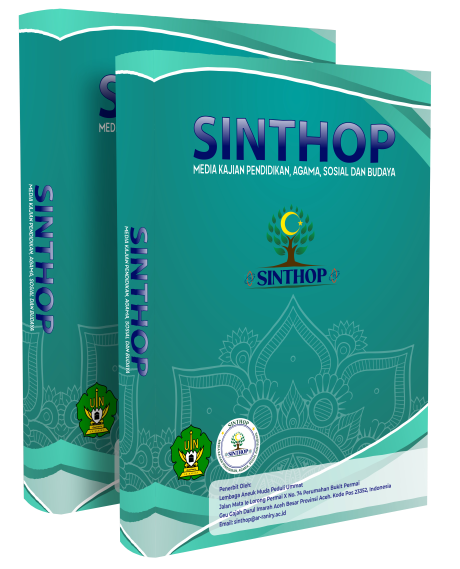Penggunaan Cadar di Kalangan Mahasiswi: Studi Tentang Makna, Motivasi, dan Diskriminasi
DOI:
https://doi.org/10.22373/sinthop.v2i2.3987Keywords:
Veil, Female Students, Motivation, Meaning, DiscriminationAbstract
This article aims to describe the meanings, motivations, and discrimination related to the use of veils among students at UIN Ar-Raniry. This research utilizes a qualitative descriptive approach, and data were obtained from various sources, including field observations, direct interviews with informants, and relevant scholarly literature. The findings of this study indicate that female students interpret the use of veils in various ways, such as self-defense, an expression of obedience to God, and an understanding of Islamic law. They also view the veil as a means to protect themselves from unwanted attention, as part of their journey of religious conversion, and as a way to maintain modesty and behavior in accordance with Islamic teachings. Motivations behind the use of veils by female students include a desire to draw closer to Islamic teachings, self-protection, and social influence. This reflects a combination of psychological, social, and spiritual factors in their decision to wear the veil. This study also reveals that some female students experience discrimination and negative stereotypes as a result of wearing veils, including being perceived as extremists or terrorists. These experiences indicate that the use of veils in an academic environment can also trigger prejudice and negative social reactions.
Abstrak
Artikel ini bertujuan untuk mendeskripsikan makna, motivasi, dan diskriminasi terkait penggunaan cadar di UIN Ar-Raniry. Penelitian ini menggunakan pendekatan deskriptif kualitatif, dan data diperoleh dari berbagai sumber, termasuk observasi lapangan, wawancara langsung dengan informan, dan literatur ilmiah yang relevan. Hasil kajian ini menunjukkan bahwa mahasiswi memaknai penggunaan cadar secara beragam seperti pertahanan diri, ekspresi ketaatan kepada Tuhan, dan pemahaman terhadap hukum Islam. Mereka juga melihat cadar sebagai cara untuk melindungi diri dari perhatian yang tidak diinginkan, sebagai bagian dari perjalanan hijrah mereka, dan sebagai sarana untuk menjaga kesopanan serta perilaku yang sesuai dengan ajaran Islam. Motivasi di balik pemakaian cadar oleh mahasiswi meliputi keinginan mendekatkan diri pada ajaran Islam, perlindungan diri, dan pengaruh sosial. Ini mencerminkan perpaduan faktor psikologis, sosial, dan spiritual dalam keputusan mereka untuk bercadar. Kajian ini juga menunjukkan bahwa beberapa mahasiswi juga mengalami diskriminasi dan stereotip negatif akibat pemakaian cadar, termasuk dianggap sebagai ekstremis atau teroris. Pengalaman tersebut mengindikasikan bahwa penggunaan cadar dilingkungan akademis juga dapat memicu prasangka dan reaksi sosial yang negatif.
References
Assingkily, M. S. (2019). Metode Penelitian Pendidikan (Panduan Menulis Artikel Ilmiah dan Tugas Akhir). Penerbit K-Media.
Boy, P. (2018). Cadar dan kompleksitas hubungan agama-budaya. Geotimes.Co.Id. https://geotimes.id/kolom/agama/cadar-dan-kompleksitas-hubungan-agama-budaya/
Danil, M. (2022). Cadar: Pengaruh Dan Proses Membentuk Ulang Identitas Diri Dalam Keminoritasan. Jurnal Pendidikan Dan Konseling (JPDK), 4(4), 65–72. http://journal.universitaspahlawan.ac.id/index.php/jpdk/article/view/5777
Hakim, L. (2023). Fenomena Bercadar Perempuan Aceh Kontemporer dalam Analisis Sejarah, Budaya dan Teologi. Jurnal Sosiologi Agama Indonesia (JSAI), 4(1), 140–159. https://doi.org/10.22373/jsai.v4i1.2704
Masudi, I. (2018). Sejarah Penggunaan Cadar Sebelum dan di Masa Islam. Islami[Dot]Co. https://islami.co/sejarah-penggunaan-cadar-sebelum-dan-di-masa-islam/
Muh. Sudirman. (2019). Cadar Bagi Wanita Muslimah (Suatu Kajian Perspektif Sejarah). DIKTUM: Jurnal Syariah Dan Hukum, 17(1), 49–64. https://doi.org/10.35905/diktum.v17i1.651
Neuman, W. L. (2014). Social Research Methods: Qualitative and Quantitative Approaches. In Pearson Education Limited. Pearson.
Pohan, R. A. (2021). Motivasi Dakwah Perempuan Bercadar: Dari Feeling of Inferiority Menuju Feeling of Superiority. Jurnal Komunika Islamika : Jurnal Ilmu Komunikasi Dan Kajian Islam, 8(1), 1. https://doi.org/10.37064/jki.v8i1.9476
Praja, W. N., Pandu Hyangsewu, & Isni Nurazizah. (2022). Interaksi sosial pada kalangan mahasiswi bercadar di lingkungan kampus. Jurnal Ilmiah Mimbar Demokrasi, 22(1), 152–156. https://doi.org/10.21009/jimd.v22i1.20734
Puspita Sari, R., & Busyro, B. (2023). CADAR DALAM KONTEKS KEKINIAN PERSPEKTIF FILSAFAT HUKUM ISLAM. Borneo : Journal of Islamic Studies, 4(1), 10–21. https://doi.org/10.37567/borneo.v4i1.2006
Rasyid, L. A., & Bukido, R. (2018). PROBLEMTIKA HUKUM CADAR DALAMISLAM: SEBUAH TINJAUAN NORMATIF-HISTORIS. Jurnal Ilmiah Al-Syir’ah, 16(1), 74. https://doi.org/10.30984/jis.v16i1.648
Ratri, L. (2011). Cadar, Media, Dan Identitas Perempuan Muslim. Forum, 39(2), 29–37.
Sesse, M. S. (2016). Aurat wanita dan hukum menutupnya menurut hukum Islam. Jurnal Al-Maiyyah, 9(2), 114.
Simehate, A. (2022). INTERAKSI SOSIAL MAHASISWI BERCADAR UNIVERSITAS SYIAH KUALA. Jurnal Ilmiah Mahasiswa Fakultas Ilmu Sosial & Ilmu Politik, 7(1), 2021. https://jim.usk.ac.id/FISIP/article/view/18855
Wahidah, N., & Nuranisah, E. (2020). DISKRIMINASI PEREMPUAN BERCADAR DALAM PERSPEKTIF HEGEMONI. Al-Mada: Jurnal Agama, Sosial, Dan Budaya, 3(1), 39–49. https://doi.org/10.31538/almada.v3i1.530
Downloads
Published
How to Cite
Issue
Section
License
Authors who publish in SINTHOP: Media Kajian Agama, Sosial dan Budaya agree to the following terms:
- Authors retain copyright and grant the journal right of first publication with the work simultaneously licensed Attribution-ShareAlike 4.0 International (CC BY-SA 4.0) that allows others to share the work with an acknowledgment of the work's authorship and initial publication in this journal.
- Authors are able to enter into separate, additional contractual arrangements for the non-exclusive distribution of the journal's published version of the work (e.g., post it to an institutional repository or publish it in a book), with an acknowledgment of its initial publication in this journal.
- Authors are permitted and encouraged to post their work online (e.g., in institutional repositories or on their website) prior to and during the submission process, as it can lead to productive exchanges, as well as earlier and greater citation of published work. (See The Effect of Open Acces)



.png)

.png)
.png)
.png)


